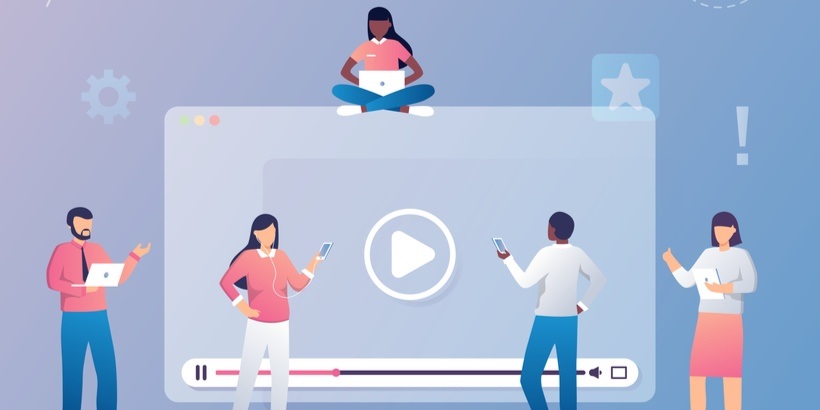Live Video Media Platform Solutions for Higher Ed

As video has become the norm on college campuses worldwide, educators have increasingly turned to video media platforms to organize video content and make it more accessible to students. Blended, flipped, and online classrooms have changed the educational landscape and become a driving force behind the rapid adoption of video on campus.
Educators recognize that video drives student engagement, improves retention, and leads to better learning outcomes. Furthermore, today's students expect video to be part of the classroom experience, with many preferring video-based learning to textbook-based learning, making it essential for institutions of higher education to effectively incorporate it into their systems.
Video management platforms enable educators to seamlessly integrate video into their classrooms, giving them the tools to quickly create, organize, and share content with students.
Here, we look at video's vital role in today's educational landscape.
Unlocking the Potential of Live Video Media Platforms
Bringing video to campus has many benefits for students and professors alike. One of the most notable benefits is the increased accessibility to the learning content that these platforms provide, empowering students to take an active role in their education.
Instructors can use these platforms to upload and organize video content into media libraries based on courses, subjects, and themes, which students can access at their convenience and learn at their own pace whenever they have time. The flexibility of these platforms makes it easier for instructors to adapt classroom materials to fit diverse learning styles and needs, leading to better educational outcomes.
When used correctly, video can help improve student engagement and collaboration through real-time interaction with peers and educators, encouraging active participation in discussions and problem-solving activities.
Video learning platforms also help optimize resources and are cost effective, cutting down on travel and accommodation expenses for students and faculty, as they no longer have to travel to campus for in-person classes. Moreover, these platforms streamline the content creation and distribution process, ensuring that the materials that students need are easily accessible and readily available.
Key Features of Live Video Media Platforms
Comprehensive video media platforms have several features that contribute to an enriched learning experience for students. One example is high-quality, low-latency streaming that ensures that educators can communicate effectively with learners with minimal disruptions and technical difficulties, making it a critical component in an educator's toolbox.
Students who can't attend class can still participate via live streaming from home or another location. When teachers have access to live streaming capabilities, they can offer webinars, tutoring sessions, and other events in real time.
Beyond live streaming, these platforms provide schools with a central location to securely store and share video content. Educators can upload videos to the platform and organize them into media libraries based on subject and theme, so students can access video content as needed to maximize learning.
Tagging and metadata make it easy for learners and educators to quickly find the content that they need within the platform. Instructors can use tags to group related content, and students can organize videos into playlists and sort them by lessons. Furthermore, lecture capture enables students to stream lectures live or revisit them later on demand.
Since your students won't always be sitting in front of a computer when it's time to study, video media platforms are compatible across devices, so students and instructors can access content whether they're using a smartphone, tablet, or laptop.
Interactive tools, high-quality streaming, and user-friendly design all come together to create an engaging experience for learners.
Best Practices for Navigating the Transition to a Live Video Media Platform
Choosing the right live video media platform is essential for making the most of streaming in the classroom. To do this, you'll need to understand your institution and thoroughly evaluate available options to find the best fit.
You'll want to make sure the platform that you select has the aforementioned features and integrates seamlessly with your university's LMS, which enables students to access video content alongside their coursework.
While platforms like Warpwire are user friendly and highly intuitive, you must ensure that adequate support is in place for faculty and students to overcome any potential barriers to adoption. Institutions of higher education should also provide faculty with resources on how to best use video content to create engaging classes that maximize learning outcomes and encourage student participation.
When schools follow these best practices, they can effectively harness the potential of video media platforms and set up students and faculty for success.
Final Thoughts
Live video media platform solutions have become indispensable tools for higher education, offering innovative and interactive ways to enrich the learning experience. They break down barriers, enhance engagement, and promote collaboration, enabling educators to connect with students beyond the traditional classroom.
As technological progress continues and the landscape of education undergoes further transformation, embracing these platform solutions will be crucial for institutions to remain at the forefront of educational innovation.
By integrating live video media platforms, institutions of higher education can ensure a dynamic and inclusive learning environment, paving the way for academic success in the digital age.
See how easy it is to deliver higher ed live streams with Warpwire Live. The learning technology provides real-time, low-latency virtual attendee experiences. Warpwire makes it easy to capture and manage video within learning environments and delivers insight into how the communities engage with the content. Schedule a demo today!
